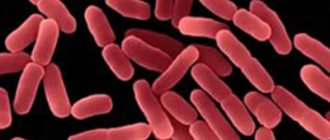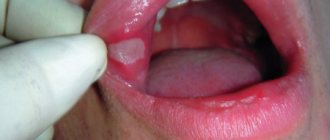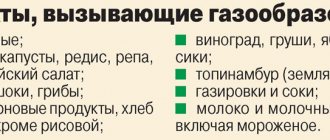- Structure and functions of the appendix
- Causes of chronic appendicitis and its types
- Symptoms of chronic appendicitis
- Diagnostics
- Treatment of chronic appendicitis
- Complications of chronic appendicitis
- Forecast
- Children, teenagers and pregnant women
Chronic appendicitis is a chronic inflammation of the appendix, which extends from the cecum. This disease is quite rare and is observed much less frequently than acute appendicitis.
In ancient times, appendicitis was known as “inflammatory tumor” or “ileal abscess”. This disease was considered fatal, and patients died in agony. Only with the development and establishment of surgery, appendicitis has become a routine disease, which can be treated in any surgical department.
With the development of the theory of evolution, many scientists began to look at the appendix as an organ unnecessary for a person, which can be completely dispensed with. This has led to an unjustified increase in the number of operations to remove the appendix. However, after its functions were discovered, doctors began to take a more moderate position, and today the voices of scientists are increasingly heard in favor of preserving the appendix and conservative treatment of appendicitis with antibiotics.
Characteristics of the pathology
When systematically exposed to certain unfavorable factors, the tissues of the human body become inflamed. The source of inflammation is localized in various areas, often affecting the gastrointestinal tract, in particular the appendix. This organ is an oblong (vermiform) appendix located in one of the sections of the cecum.
In chronic appendicitis, the inflammation is mild, which is what causes the development of a blurred clinical picture. However, with prolonged inflammation, the structure of the appendix tissue changes, granules, scars, and adhesions appear. Such disorders lead to loss of functionality of the appendix (although it was previously believed that this organ did not perform any functions, but today this statement has been refuted) and the appearance of specific symptoms.
Possible consequences
When treated with a conservative method, the disease may be complicated by an acute attack and surgical intervention may be required.
In some cases, the formation of an appendiceal infiltrate is possible. It is treated with cold, anti-inflammatory, painkillers, and physiotherapeutic methods. After relief of signs of inflammation, it is recommended to remove the appendage after 3-4 months.
Other complications of chronic appendicitis:
- Abscess of the appendix. It is treated surgically.
- Adhesive disease. It is treated with physiotherapeutic methods or through surgery.
- Diffuse peritonitis is a rupture of the appendix with its contents entering the abdominal cavity.
Causes and risk factors
The main reason for the development of the pathology is considered to be an acute form of appendicitis, which the patient had previously suffered (if the appendix was not surgically removed). Depending on the root cause, the following forms of the disease are distinguished:
- Primary chronic form of appendicitis, the causes of which are not established, but there are various predisposing factors;
- Secondary chronic form of appendicitis, developing after an acute attack, if the patient was not prescribed surgical treatment. Secondary appendicitis can be recurrent, and the pathology has a wave-like course (symptoms appear and then subside, resuming after a short period of time).
Risk factors
Adverse effects that can lead to the development of a chronic form of the disease (but not always) include:
- Chronic fatigue, susceptibility to stress and overwork;
- Infectious diseases. Damaging organs of the gastrointestinal tract;
- Persistent disruption of the immune system and autoimmune pathologies;
- Errors in nutrition, including eating large amounts of fatty meat, systematic overeating;
- Prolonged exposure to negative temperatures (general or local hypothermia);
- Overweight;
- Wrong lifestyle and bad habits;
- Changes in stool (constipation) developing against the background of gastritis, peptic ulcers and other pathologies of the digestive system;
- Activities that involve frequent heavy lifting.
Expert opinion
Shoshorin Yuri
General practitioner, site expert
These reasons do not always contribute to the development of chronic appendicitis, but significantly increase the risk of the problem occurring, negatively affecting the general condition of the body.
Forms of the disease
There are three forms of chronic appendicitis:
- residual (residual) form - develops after a previous acute appendicitis, which ended in recovery without surgical intervention;
- primary chronic form - develops slowly, without a previous attack of acute appendicitis. Some experts question its presence, so the diagnosis of primary chronic appendicitis is made only after excluding the presence of any other pathology that can cause a similar clinical picture;
- relapsing form - characterized by recurrent symptoms of acute appendicitis in the patient, which subside after the disease goes into remission.
At any time, chronic appendicitis can turn into an acute form, and untimely surgical operation in this case threatens the development of peritonitis, a potentially life-threatening condition.
Stages, symptoms and complications of chronic appendicitis
Depending on the symptoms present, there are 2 stages of chronic appendicitis. This is the stage of exacerbation and the period of remission. Each of them has its own symptoms.
| Stage | Characteristic signs | Possible complications |
| Exacerbation period | The exacerbation stage is characterized by more pronounced symptoms, such as:
| Despite the fact that the symptoms of the chronic form of the pathology are less pronounced than those of acute appendicitis, this disease is still considered very dangerous and can lead to various serious complications. First of all, prolonged inflammation significantly weakens the walls of the appendix, which means there is a threat of its rupture. When the appendix ruptures, the purulent contents that accumulate in its cavity enter the bloodstream and spread throughout the body, causing severe intoxication and the risk of death. In addition, adhesions and scars form in the tissues of the affected appendix, which can lead to the development of intestinal obstruction and death of organ cells. |
| Remission stage | At this stage, the characteristic symptoms of the disease temporarily recede; the presence of an inflammatory process may be indicated by such signs as:
|
Characteristic symptoms
Chronic appendicitis is characterized by mild symptoms that are quite easily confused with other conditions. For the same reason, pathology can be difficult to diagnose. Mild aching pain in the navel or lower abdomen on the right may be the only symptom. The pain intensifies during physical activity and may be accompanied by increased gas formation, nausea, and stool disorders.
Chronic inflammation may present with other (optional) symptoms, including:
- low-grade fever;
- swelling and increased sensitivity in the lower abdomen;
- lethargy and chronic fatigue;
- loose stools, nausea.
Appendicitis is inflammation of the appendix of the rectum.
These symptoms may be present in various combinations or absent altogether. The course of the disease is individual. It should be borne in mind that periodic pain in the lower abdomen on the right, especially in combination with other suspicious symptoms, indicates the need to see a doctor. Internal obstruction of the appendix can progress from partial to complete. Increasing symptoms indicate a possible transition to an acute form with attendant dangerous consequences.
Symptoms of an exacerbation include:
- nausea with vomiting;
- high temperature;
- long-term stool disorder;
- bloating, difficulty passing gases from the intestines;
- complete lack of appetite.
Medical examination and diagnosis are also relevant if symptoms have temporarily stopped, since it is impossible to predict when they will occur next and with what intensity.
In pregnant women, the pathology manifests itself similarly, but the pain often radiates to the right leg. Characterized by alternating constipation and diarrhea.
Features in children
Manifestations of childhood appendicitis may differ slightly from the clinical picture in adults. The immaturity of many functions of the child’s body leads to the disease becoming more severe. There is an increased likelihood of complications. Symptoms depend on the type of inflammation, but more often they manifest themselves as constant aching pain in the epigastric region or in the navel area, which increases, finally localizing at the site of the appendix projection. The child cries, is restless, loses appetite and sleep, the baby bends over to the right side or tries to lie on the right side, since lying on the left side increases pain.
In young children, the structural features of the appendix are not conducive to the development of inflammation. Therefore, the disease is extremely rare before the age of 3 years.
Exacerbation of appendicitis causes attacks of vomiting, which does not bring relief. The body temperature is subfebrile, but during exacerbation it can reach 38 ° C or more. The stool becomes loose and frequent. The tongue is partially or completely covered with a white coating.
Distinctive symptoms in women
Specific manifestations of chronic appendicitis in women include:
- increased symptoms of pain when pressing on the abdomen just below the navel (unlike urological pathologies, when pain, on the contrary, decreases);
- increased pain in the appendix area during vaginal examination.
If pain occurs during a vaginal examination when palpating the cervix, the cause is most likely not appendicitis.
Distinctive symptoms in men
In men, when palpating for chronic inflammation of the appendix, the following signs can be noticed:
- pulling up the right testicle when pressing on the area of the cecum;
- discomfort/pain in the right testicle with slight stretching of the scrotum.
Diagnostic methods
Due to the fact that the clinical picture of chronic appendicitis is blurred, it is almost impossible to make a diagnosis based on patient complaints alone, therefore, modern diagnosis involves the use of other, more informative methods:
- Contrast radiography. A special thin tube is inserted into the patient through the anus, through which a barium solution (contrast agent) enters the large intestine. If the solution cannot fill the appendix, an inflammatory process occurs. This method allows not only to determine inflammation, but also to determine the size and shape of the process;
- Colonoscopy is a method that involves the use of a miniature camera that is inserted into the intestinal area. This method is used to identify the causes of pathology (tumors, cysts, changes in the mucous membrane);
- Ultrasound of the peritoneal organs. The study is carried out on an empty stomach. Allows you to assess the condition of other organs of the gastrointestinal tract and determine their possible damage;
- OAM is performed in the morning, it allows you to detect leukocytosis (in the presence of inflammation in the body, the level of leukocytes in the urine increases);
- CBC to determine ESR (this indicator is also exceeded, which indicates the development of an inflammatory process).
Signs of appendicitis
The disease begins with pain in the umbilical region, which is cutting and wave-like in nature. After a few hours, pain migrates to the right iliac region. In some cases, the pain is localized throughout the abdomen, without a clear localization, which often results in a feeling of nausea and sometimes vomiting.
One of the diagnostic criteria is tension in the abdominal muscles. There is an increase in temperature to 38-39 degrees.
If you suspect appendicitis, you should call an ambulance. The earlier treatment is started, the more favorable the outcome will be.
Symptoms of appendicitis in children, women and men may differ.
Treatment methods
Until recently, it was believed that the appendix was an organ that did not have any functional load. Therefore, when the inflammatory process developed, it was simply removed. Today there are facts indicating that the appendix is part of the immune system (takes part in the formation of local immunity in the intestines), and has secretory and hormonal functions.
Therefore, in modern medicine it is now common to use conservative treatment methods, and surgical operations are used only as a last resort.
Surgery
Appendectomy is a surgical operation to remove the appendix. The procedure is performed under general anesthesia. Removal of the appendix can be carried out either openly (through an incision) or by laparoscopy (in the area of the appendix, the doctor makes several punctures through which surgical manipulations are carried out using a laparoscope). The second option is considered less traumatic and, therefore, more preferable.
Conservative treatment
Non-surgical treatment includes adjustments to diet and lifestyle, as well as the use of medications prescribed by a doctor.
Etiology and pathogenesis
The cause of appendicitis is blockage of the lumen of the appendix. It may be due to:
- fecal stone (the most common cause);
- solid food particles;
- helminthic infestation.
The pathogenesis of the disease is dominated by the development of a vicious circle. Induced inflammation with the development of lumen obturation leads to compression of the vessels of the appendix, which, in turn, causes increased secretion of mucus into the lumen of the appendix. Due to the released mucus, intra-appendicular pressure increases - this leads to an increase in the inflammatory process.
The liquid part of the blood from the compressed venous and lymph nodes flows into the lumen of the appendicular process and stretches it even more. Ischemia of the organ develops due to compression of the feeding vessels. Stagnation leads to the proliferation of pathogenic microflora, which further increases inflammation.
The principle of conservative treatment of appendicitis is based on a multi-stage effect on all stages of the pathogenesis of the disease.
Medicines
| Drug name | Description | Admission rules | Price |
| Zinatsef | It has an antimicrobial effect and is produced in the form of a powder for injection (intravenous or intramuscular). | 750 mg per day, in severe cases of the disease the dose is increased by 2 times. Duration – 7-14 days. | 150 rub. |
| No-Shpa | It has an antispasmodic and analgesic effect. In the chronic form, the patient is prescribed the drug in the form of tablets for oral administration. | 80-320 mg of the drug, depending on the severity of symptoms. Duration 5-7 days. | 70 rub. |
| Cerucal | Antiemetic drug in tablet form. Relieves attacks of nausea, improves well-being. | 1-4 tablets per day. Duration – up to 6 weeks. | 120 rub. |
| Nifuroxazide | An antidiarrheal agent that normalizes stool, eliminates bloating and flatulence. | 2-8 tablets per day. Duration – up to 10 days. | 200 rub. |
Additionally, regarding the symptoms of chronic appendicitis, we recommend that you read the material on the website med.vesti.ru. Also, regarding treatment methods and diet, we recommend that you read the comments of the doctor of the State Medical Center named after. A.I. Burnazyan FMBA for a specific patient diagnosis (36 year old woman): https://health.mail.ru/consultation/1663529/
Folk remedies in the fight against inflammation
It should be noted that before starting self-medication with folk remedies, you should consult a doctor. Treatment of appendicitis at home with folk remedies is controversial.
The most effective ways:
- Brew 20 grams of crushed burdock leaves with a glass of boiling water, leave and drink half a glass every hour throughout the day.
- In equal proportions you need to take 20 grams of wormwood and mistletoe. Grind, brew a glass of boiling water, and drink half a glass three times a day.
Diet correction
During the treatment period, the patient must introduce a number of restrictions into his diet. It is important to exclude all foods that are difficult for digestion and burden the gastrointestinal tract.
| Allowed | Forbidden |
|
|
Evidence of the effectiveness of drug treatment. Statistics
Conservative treatment of acute appendicitis is really effective. Not always, because there are cases when surgery cannot be avoided. In particular, this is chronic appendicitis - it always needs to be “cut”. But most often, antibacterial therapy is enough to completely cure the disease.
So, several years ago, The British Medical Journal conducted a large-scale analysis of the condition of 900 people with an inflamed appendix. Of these, 430 underwent surgery, and 470 took antibiotics. The success rate of drug treatment was 63%, and in another 37% of cases surgery was still required. In addition, complications occurred 31% less often in “pill” patients than in those who underwent surgery. The study authors concluded that the pills do not always help avoid surgery, but if they succeed, then the risk of complications after the disease becomes minimal. The American Journal of American College of Surgeons conducted a similar study among children and adolescents aged 7-17 years. Thirty patients took antibiotics, and 93% of them showed a significant improvement in their general condition within 24 hours.
Diet
For symptoms of chronic appendicitis in adults , as well as after surgery, you must follow a diet. Food is steamed or boiled. Food is consumed warm; hot or cold foods should not be eaten.
Prohibited products:
- bread, pastries;
- smoked meats;
- canned food;
- sweets;
- legumes;
- fatty meat, poultry, fish;
- pasta;
- mushrooms;
- industrial sauces;
- cereals;
- sour fruits and apples;
- white cabbage, spinach, sorrel.
The diet includes:
- low-fat varieties of fish without skin;
- eggs cooked soft-boiled or steamed;
- pureed vegetable soups;
- steamed cutlets from lean meat;
- semolina and oatmeal.
It is necessary to reduce the amount of salt consumed to 5-8 g per day.
Why does the appendix become inflamed?
Performing protective functions, the appendage primarily responds to pathological processes in the stomach and intestines. With strong and frequent stress on the lymphoid tissue, swelling of the organ walls occurs. This leads to stagnation of its contents and provokes an inflammatory process (appendicitis). First, suppuration of the mucous membrane of the organ develops, gradually affecting all layers of its walls.
The appendage is not capable of accumulating hard, indigestible food particles (bones, seed husks, etc.). Its entrance hole is too small for this (up to two millimeters). However, food preferences and allergic reactions can trigger the destructive process. The cause of appendicitis in women is inflammation of the uterine appendages or changes in hormonal levels.
For a long time, chronic appendicitis was not identified as a separate nosological entity. This rare type of disease is diagnosed in only one percent of cases.
Differences between chronic and acute forms
| Acute | Chronic | |
| Pain | Lasts several days and disappears with tissue necrosis | Arises quickly and also quickly stops |
| Localization of pain syndrome | First in the area of the stomach and navel, and only then moves to the right side of the abdomen | Chronic appendicitis hurts from time to time. Pain occurs immediately in the lower right abdomen |
| Temperature readings and heart rate | Are rising | Remain unchanged |
| Outcome of inflammation | Ends with rupture of the process | The pathological process continues to progress sluggishly |
It is difficult to detect chronic appendicitis using a blood test, since the number of leukocytes remains normal, and an increase in this indicator is rarely observed.
Prevention
You should change your lifestyle , no stress, give up bad habits and eat right. It is advisable to lose excess weight.
Recent studies have shown that the appendix is a full-fledged organ and should not be removed unless absolutely necessary. Considering the low prevalence of this disease and the controversy surrounding this pathology, it is better to promptly inform your doctor about strange sensations in the body .
If a person has experienced an attack of acute appendicitis, the likelihood of developing a chronic form increases significantly. This pathology is quite rare; young and middle-aged people (20-40 years old) are more often susceptible to it. It is more often diagnosed in women than in men. Let's figure out what chronic appendicitis is, what are the causes, symptoms and methods of combating the disease.
What can be confused with
Differential diagnosis is made with other inflammatory diseases of the abdominal organs (pancreatitis, cholecystitis, acute gastritis), as well as with changes in the genitourinary system. Particular attention should be paid to the presence of irradiation. Pain in most other diseases radiates to other parts of the body. This does not happen with appendicitis.
To clarify the diagnosis, non-invasive imaging techniques are used: radiography, sonography, computed tomography and magnetic resonance imaging. Using these methods, it is possible to build a model of the appendix without resorting to traumatic manipulations. In rare cases, when non-invasive diagnostic methods are ineffective, diagnostic laparoscopy or laparotomy is prescribed.
Complications
The disease may bother a person for several years . It can even take an acute form, and sometimes causes intestinal obstruction. It is also possible for adhesions to develop.
In case of exacerbation of the disease emergency medical care , otherwise gangrene or perforation of the appendix may develop.
If the operation was performed poorly, bleeding occurs in the peritoneum due to improper doping of the vessels.
Sometimes an abscess develops because the exudate was carelessly removed. In these cases, hospitalization is required . In the hospital, the cause of the exacerbation will be determined and the hemorrhage will be eliminated or the abscess will be opened.
What is the difficulty in identifying the disease?
An attack of appendicitis “attacks” the patient suddenly, often in the evening or at night. An hour ago I was feeling great, and suddenly it suddenly deteriorates.
Appendicitis may be indicated by:
- Dull pain first around the navel, then moving down to the right. Sharp pain attacks occur during physical activity, coughing, sneezing. If you lie on your left side, the pain intensifies.
- Loss of appetite, dry mouth, yellowish coating on the tongue.
- Increase in temperature, sometimes up to 38 degrees. Older women usually do not have this sign; the temperature may even drop.
- Chills, increased heart rate.
- Stomach upset, frequent urination, nausea, possible vomiting. The abdomen swells, becomes hard and dense.
- Feeling tired, pale, dark circles under the eyes.
Sometimes a woman perceives an attack of appendicitis as food poisoning. The disease is also mistaken for intestinal colic, exacerbation of cholecystitis, and other diseases of the digestive system.
In women, it can “simulate” an ectopic pregnancy, inflammation of the appendages, or rupture of a cyst in the ovary.
In some women, it is especially difficult to detect the onset of inflammation. These include:
- Ladies of Balzac age. Usually they do not have severe pain, fever, or increased heart rate.
- Women during "critical days". The latter are often accompanied by painful sensations. And inflammation often occurs during this period due to the proximity of organs and possible infection.
- Pregnant women. During fetal growth, internal organs shift, put pressure on each other, and normal blood flow is disrupted. Therefore, the symptoms and signs of appendicitis in pregnant women are mistaken for toxicosis, especially in the second half of pregnancy they are blurred - there is no severe pain or fever.
There are other women who are at risk for the difficulty of identifying the first signs of the disease and the severity of its course.
These are overweight ladies and those who suffer from diabetes and oncology.
If alarming symptoms occur, you need to call an ambulance. The patient should be put to bed and a cold compress should be applied to the area of discomfort.
What not to do while waiting for the doctor:
- apply a warm heating pad to the sore spot;
- take painkillers, antibiotics and laxatives (it will be difficult to make an accurate diagnosis);
- be treated with traditional medicine;
- physically strain;
- eat and drink.
Even if the attack subsides before calling the ambulance, it is still worth visiting a doctor. Suddenly, necrosis of the cells of the appendix began, and the nerve endings died.
You don’t feel pain, but inflammation develops. Delay can have dire consequences.
Anatomical information
The small hollow tube that attaches to the bottom of the cecum is called the appendix, or appendix.
Its diameter is about one centimeter, and its length does not exceed 15 cm. The second end is closed, that is, the process does not lead anywhere, for which it received the name “blind”. In the projection onto the abdominal cavity - located in its lower part on the right side. It does not take part in the process of digesting food, although it is part of the intestines. But its functions are no less important:
- supports protective reactions in the body - the walls of the appendix consist of lymphoid accumulations, the cells of which perform a number of immune functions;
- produces amylase;
- accumulates microorganisms useful for the gastrointestinal tract and distributes them throughout the organ in the event of the death of its microflora;
- produces peristaltic hormone;
- synthesizes an antimicrobial substance - this area has been poorly studied.
Observations have shown that children who have an appendix grow and develop much better than those who have had it removed.
Inflammatory processes with pronounced symptoms are classified as acute appendicitis. In the case of a sluggish course of the disease with unstable, mild symptoms, its chronic form occurs.










